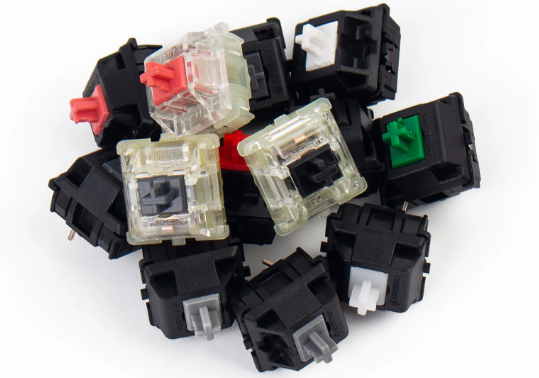A keyboard switch is a mechanical component that allows input information to translate from keystrokes into computer commands. There are various types of keyboard switches available, each offering distinct advantages and disadvantages. The main differences between different keyboard switches are the materials used, the level of key resistance or “feel,” and the degree of noise produced during use. In this article, we’ll explore the differences between the most common keyboard switches and help you understand which type might be best suited for your needs.

Difference Between Different Keyboard Switches
Mechanical Switches
Mechanical switches are the most common type of keyboard switch and are known for their durability and tactile feedback. They’re typically more expensive but offer more significant features for gamers or people who type frequently. The mechanical switch keyboard features a stem that is pushed down into a spring, closing a circuit that sends the keystroke signal to the computer. The key can be removed and replaced easily, making customization much easier, making it a popular choice for gamers.
Various types of mechanical switches are available, each offering different key resistance, noise level, and durability. For example, Cherry MX switches are the most popular mechanical switches, with the brand offering a range of types with different colors to denote the level of resistance and feedback provided. Some switches are linear, and others are tactile, providing a click-like feel. Mechanical switches are considered to be reliable, long-lasting, and more comfortable to use, making them a top choice for many users.
Dome Switches
Dome switches, also known as rubber dome switches, are the most common type of keyboard switch found in many budget keyboards. A dome switch uses a rubber dome mounted over a circuit board with each key containing a dome. When a key is pressed, the rubber dome pushes down and closes the circuit, and sends the keystroke signal to the computer.
Dome switch keyboards are less expensive than mechanical switches but have relative drawbacks. The keys have less tactile feedback and are typically quieter, making them suitable for quiet working environments. Dome switches have consistent resistance, which takes a short time to get used to. With continued use the rubber domes’ performance may degrade, leading to the keys failing to work accurately.
Scissor Switches
Scissor switches are a variation of the dome switch, providing a slimmer profile and improved durability. Scissor switches keyboards use two plastic pieces working together to provide a stable base for the key caps while offering more tactile feedback with keypresses. The scissors, which hold the keycaps, provide a shorter stroke and lower actuation force than dome switches, providing quicker typing and feedback.
Scissor switches are known for their low-profile design and are commonly used in laptops, keyboard covers, and keyboards with low profiles. The design improves the typing experience by providing more tactile feedback, making it ideal for frequent typists who desire a more comfortable keyboard at a more affordable cost.
Hall Effect Switches
Hall Effect switches are a newer type of switch becoming more popular in gaming keyboards. These switches use magnets and a sensing circuit to detect keystrokes. They have an optimal typing experience by increasing the speed with an accurate and fast response, ideal for gamers.
Optical Switches
Optical switches use LED or infrared technology to detect the keystroke. They offer excellent durability with response times that are more rapid than traditional mechanical switches. They do not suffer as much from the same wear points as traditional mechanical switches.
Conclusion
The difference between different keyboard switches determines the feel, noise level, and durability. Mechanical switches are the most common type of keyboard switches and provide the most significant features. They are durable, tactile, and provide resistance, making them ideal for gamers or frequent typists. Dome switches are ideal for users on a budget and are quiet, but providing less tactile feedback. Scissor switches offer a comfortable typing experience and a low profile making them ideal for light typing tasks. It is essential to understand the differences between these keyboard switches before investing in one so you can make an informed decision, based on your needs and preference rather than just looks.